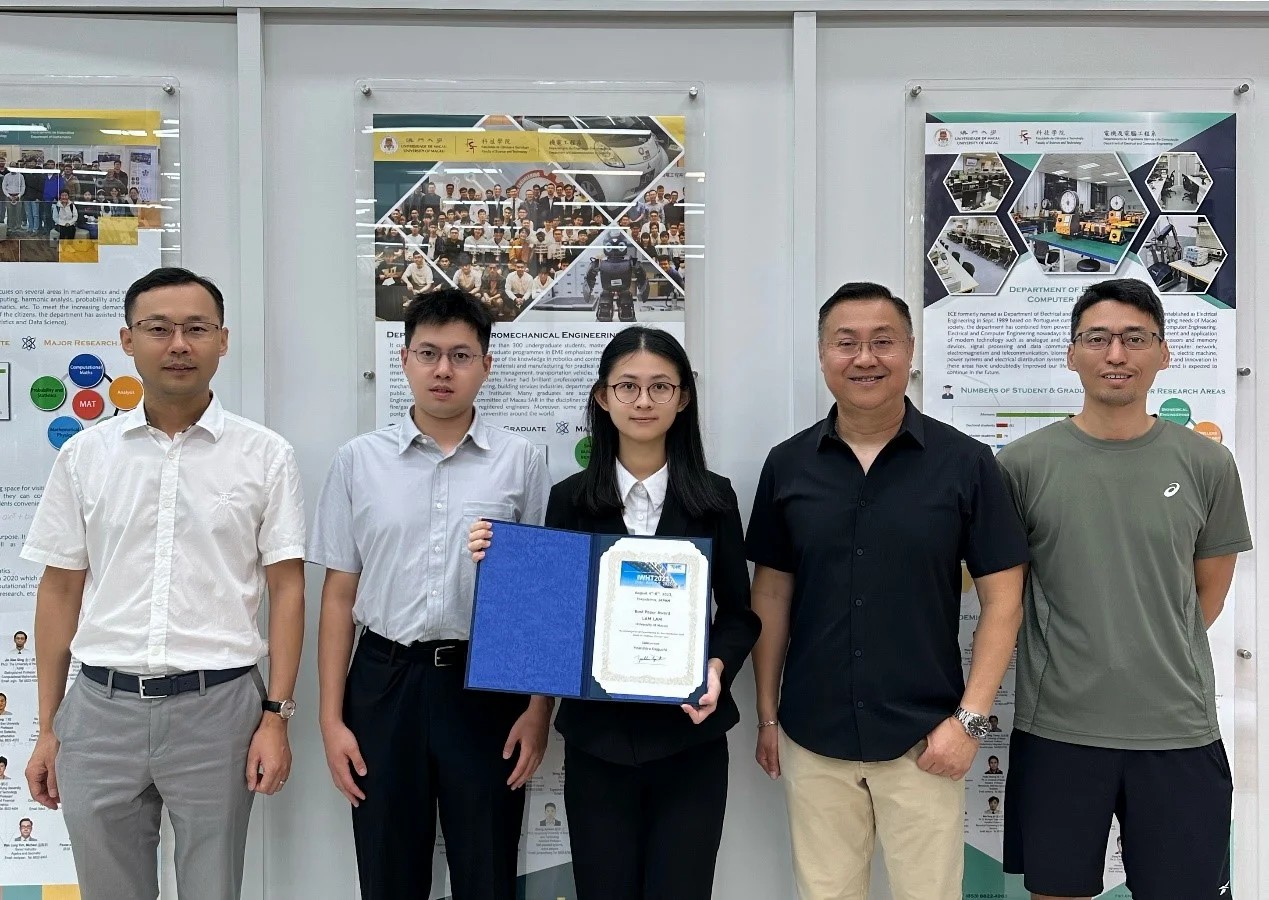Lam Lam and Song Naihe, recent graduates in the Department of Electromechanical Engineering (EME) of the Faculty of Science and Technology, University of Macau (UM), presented their research on hyperthermia applications at the 7th International Workshop on Heat-Mass Transfer Advances for Energy Conservation and Pollution Control (IWHT 2023). The study provides a basis for the amount of heat required by microrobots to generate hyperthermia in blood vessels. It was well received by the judges and won the best paper award.
The award-winning research project ‘An Investigation of Hyperthermia for Non-Newtonian Fluid inside an Imitation Circular Vein’ was built on Lam and Song’s final year project. Under the guidance of Tam Lap Mou and Xu Qingsong, professors in the EME, Lam and Song designed the experimental method, built the measurement platform, and managed the fabrication of artificial blood, data collection, and analysis. Tam Hou Kuan, EME PhD graduate at UM, gave them professional advice on selecting experimental equipment, while PhD candidate Yang Yifan assisted them in developing a numerical simulation model to carry out comparative analyses of experimental data. Lam and Song are currently pursuing further studies and research in thermal engineering at UM and Tsinghua University.
Hyperthermia is a type of oncological treatment that aims to raise the body temperature of the target subject above the normal value. Previous studies have shown that when the temperature of a cell or mass is raised to 43 ℃, the destruction of the mass can be observed. Thanks to significant advancements in manufacturing technologies and robotics in recent years, thermal engineering researchers are able to conduct hyperthermia experiments using artificial veins, artificial blood, and microrobots with mobility and heating functions. The study aimed to determine the magnitude of the heat source required to generate hyperthermia and the section that hyperthermia can cover. A blood circulation system with a pulsation flow rate of 5 cm/s was built, and an artificial vein, with an inner diameter of 2 mm and a length of 6 cm, was used as the test section. Non-Newtonian artificial blood was used as the test fluid, and the entrance temperature of the test section was kept at 37 ℃. A small-scale resistance heat source, which was used to mimic the heat generated by microrobots, was placed inside the artificial vein to enhance the inner wall temperature of the test section. Different heating inputs were used, and it was found that hyperthermia was observed when the heat input was in the vicinity of 0.22 W. The research results of the study provide a basis for the amount of heat required by the microrobots to generate hyperthermia in blood vessels. The research project was supported by the Institute for the Development and Quality, Macau.
The International Workshop on Heat-Mass Transfer Advances for Energy Conservation and Pollution Control (IWHT), launched by the MOE Laboratory of Thermo-Fluid Science and Engineering of Xi’an Jiaotong University in 2011, is an international conference for exchanging research results on advanced heat and mass transfer technologies and areas related to energy saving and pollution control. The conference was held every two years, and the previous editions were held in Russia, the United States, China’s Harbin, Xi’an, and Taiwan. It has become one of the top conferences in the field, attracting experts from all over the world. This year’s IWHT was hosted by Tokushima University in Japan, and Tao Wenquan, a member of the Chinese Academy of Sciences, was the chairman of the International Scientific Committee. More than 130 papers were presented at the conference, and the paper presented by UM was one of the four best papers selected by a committee comprising experts from the United States, Japan, and China.
澳門大學科技學院機電工程系本科畢業生林霖和宋乃禾於第七屆節能控排傳熱進展國際研討會發表了關於熱療應用的研究。她們的研究為微型機器人在血管內產生熱療效果所需熱量提供了依據,因此得到評審的一致好評並獲得最佳論文獎。
是次獲獎研究課題《人造靜脈內非牛頓流體熱療應用研究》基於林霖和宋乃禾的畢業設計。在澳大機電工程系教授譚立武及徐青松聯合指導下,兩位本科生一手包辦實驗、測量平台的構建、人造血液的調配、數據採集以及分析。此實驗由澳大機電工程系博士譚浩崑在實驗設備的選擇上給予專業建議,並由博士研究生楊伊凡協助下建立數學模型與實驗數據進行比較分析。兩位同學在畢業後於澳大及清華大學繼續學業並從事熱能工程的研究。
熱療是一種基於過熱溫度的腫瘤療法,旨在使目標對象的溫度超出體溫正常值。過去的學術研究指出,當細胞的溫度升高到43 ℃ 時,可以觀察到它被破壞的現象。由於近年相關製造技術和機器人技術的發展突飛猛進,熱能工程研究人員能夠利用人造靜脈、人造血液和具有移動及加熱功能的微型機器人進行熱療實驗。是次課題組的研究目的主要是確定實現熱療所需的熱源功率大小以及熱療所能覆蓋的範圍,故在實驗中建立了一個流速為5cm/s且測試段入口溫度保持在37 ℃ 的血液循環系統,以一條內徑為2 mm、長度為6 cm的仿製靜脈為測試段,將非牛頓流體的人造血液作為測試液體,並在人造靜脈內放置了一個小型的電阻作為熱源,使受試區的人造血管內壁溫度升高。在電阻熱源輸入不同的電功率期間,課題組發現當功率接近0.22W時,可以測量到管壁產生有效的熱療溫度。研究結果為微型機器人在血管內產生熱療效果所需熱量提供了依據。有關研究獲澳門發展及質量研究所資助。
節能控排傳熱進展國際研討會始於2011年,是由西安交通大學熱流科學與工程教育部重點實驗室發起,以交流前沿熱傳/質傳技術以及節能污染控制相關領域研究成果的國際會議,往屆會議於俄羅斯、美國,以及中國的哈爾濱、西安、台灣地區等地舉行,每兩年舉辦一屆,現已成為此領域其中的一個品牌會議,吸引了世界各地的專家參與。今屆研討會由日本德島大學主辦,並由中國科學院院士陶文銓擔任國際學術委員會主席。此次研討會有超過130份論文報告,最佳論文評審委員會由美國、日本、中國等地的專家組成,共選出四份最佳論文,澳大團隊的論文是其中之一。


